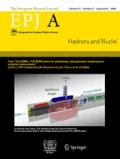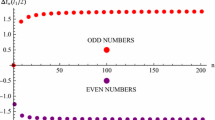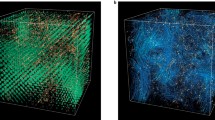Abstract.
Observable consequences of the hypothesis that the observed universe is a numerical simulation performed on a space-time lattice or grid are explored. The simulation scenario is first motivated by extrapolating current trends in computational resource requirements for lattice QCD into the future. Using the historical development of lattice gauge theory technology as a guide, we assume that our universe is an early numerical simulation and investigate potentially observable consequences. Among the observables that are considered are the muon g - 2 and the current differences between determinations of \( \alpha\), but the most stringent bound on the inverse lattice spacing of the universe, \( b^{-1}\gtrsim 10^{11}\) GeV, is derived from the high-energy cut off of the cosmic ray spectrum. The numerical simulation scenario could reveal itself in the distributions of the highest-energy cosmic rays exhibiting a degree of rotational symmetry breaking that reflects the structure of the underlying lattice.
Similar content being viewed by others
References
N. Bostrom, Philos. Q. 53, 243 (2003)
A.S. Kronfeld, arXiv:1209.3468 [physics.hist-ph] (2012)
Z. Fodor, C. Hoelbling, Rev. Mod. Phys. 84, 449 (2012) arXiv:1203.4789 [hep-lat]
S.R. Beane, arXiv:1206.5219 [hep-lat] (2012)
T. Yamazaki, arXiv:1207.4277 [hep-lat]
HAL QCD Collaboration (S. Aoki), arXiv:1206.5088 [hep-lat] (2012)
S. Lloyd, Nature 406, 1047 (1999) arXiv:quant-ph/9908043
S. Lloyd, arXiv:quant-ph/0501135 [quant-ph] (2005)
K. Zuse, Rechnender Raum (Friedrich Vieweg and Sohn, Braunschweig, 1969)
E. Fredkin, Physica D 45, 254 (1990)
S. Wolfram, A New Kind of Science (Wolfram Media, 2002) p. 1197
G.'t Hooft, arXiv:1205.4107 [quant-ph] (2012)
J. Church, Am. J. Math. 58, 435 (1936)
A. Turing, Proc. London Math. Soc. Ser. 2 442, 230 (1936)
D. Deutsch, Proc. R. Soc. London A 400, 97 (1985)
J. Barrow, Living in a Simulated Universe, edited by B. Carr (Cambridge University Press, 2008) Chapt. 27 Universe or Multiverse? pp. 481--486
MILC Collaboration, http://physics.indiana.edu/~sg/milc.html
J.B. Kogut, L. Susskind, Phys. Rev. D 11, 395 (1975)
SPECTRUM Collaboration, http://usqcd.jlab.org/projects/AnisoGen/
K.G. Wilson, Phys. Rev. D 10, 2445 (1974)
B. Sheikholeslami, R. Wohlert, Nucl. Phys. B 259, 572 (1985)
Hadron Spectrum Collaboration (H.-W. Lin et al.), Phys. Rev. D 79, 034502 (2009) arXiv:0810.3588 [hep-lat]
V. Vinge, Science and Engineering in the Era of Cyberspace, edited by G.A. Landis (NASA Publication, 1993) CP-10129, Vision-21: Interdisciplinary, 115
R. Kurzweil, The Singularity Is Near: When Humans Transcend Biology (Penguin Non-Classics, 2006) ISBN 0143037889
S.R. Coleman, S.L. Glashow, Phys. Rev. D 59, 116008 (1999) arXiv:hep-ph/9812418
O. Gagnon, G.D. Moore, Phys. Rev. D 70, 065002 (2004) arXiv:hep-ph/0404196 [hep-ph]
J. Collins et al., Phys. Rev. Lett. 93, 191301 (2004) arXiv:gr-qc/0403053 [gr-qc]
S. Kachru et al., Phys. Rev. D 68, 046005 (2003) arXiv:hep-th/0301240 [hep-th]
L. Susskind, arXiv:hep-th/0302219 [hep-th] (2003)
M.R. Douglas, JHEP 05, 046 (2003) arXiv:hep-th/0303194 [hep-th]
T. Appelquist, arXiv:1204.6000 [hep-ph] (2012)
S. Hsu, A. Zee, Mod. Phys. Lett. A 21, 1495 (2006) arXiv:physics/0510102 [physics]
K. Symanzik, Nucl. Phys. B 226, 187 (1983)
K. Symanzik, Nucl. Phys. B 226, 205 (1983)
G. Aslanyan, A.V. Manohar, JCAP 06, 003 (2012) arXiv:1104.0015 [astro-ph.CO]
P. Jizba et al., Phys. Rev. D 81, 084030 (2010) arXiv:0912.2253 [hep-th]
D.B. Kaplan, S. Sun, Phys. Rev. Lett. 108, 181807 (2012) arXiv:1112.0302 [hep-ph]
M. Lüscher, P. Weisz, Commun. Math. Phys. 97, 59 (1985)
P.J. Mohr, arXiv:1203.5425 [physics.atom-ph] (2012)
R. Bouchendira et al., Phys. Rev. Lett. 106, 080801 (2011)
D. Colladay, V.A. Kostelecký, Phys. Rev. D 55, 6760 (1997)
R.C. Myers, M. Pospelov, Phys. Rev. Lett. 90, 211601 (2003) arXiv:hep-ph/0301124 [hep-ph]
S.M. Carroll et al., Phys. Rev. D 41, 1231 (1990)
P. Laurent et al., Phys. Rev. D 83, 121301 (2011) arXiv:1106.1068 [astro-ph.HE]
L. Maccione et al., JCAP 04, 022 (2009) arXiv:0902.1756 [astro-ph.HE]
I. Motie, S.-S. Xue, Int. J. Mod. Phys. A 27, 1250104 (2012) arXiv:1206.0709 [hep-ph]
S.-S. Xue, Phys. Lett. B 706, 213 (2011) arXiv:1110.1317 [hep-ph]
OPERA Collaboration (T. Adam), arXiv:1109.4897 [hep-ex] (2011)
S.R. Coleman, S.L. Glashow, Phys. Lett. B 405, 149 (1997) arXiv:hep-ph/9703240 [hep-ph]
K. Greisen, Phys. Rev. Lett. 16, 748 (1966)
G. Zatsepin, V. Kuzmin, JETP Lett. 4, 78 (1966)
Pierre Auger Collaboration (J. Abraham et al.), Phys. Lett. B 685, 239 (2010) arXiv:1002.1975 [astro-ph.HE]
HiRes Collaboration (P. Sokolsky et al.), PoS ICHEP2010, 444 (2010) arXiv:1010.2690 [astro-ph.HE]
Author information
Authors and Affiliations
Corresponding author
Additional information
Communicated by U.-G. Meißner
Rights and permissions
About this article
Cite this article
Beane, S.R., Davoudi, Z. & J. Savage, M. Constraints on the universe as a numerical simulation. Eur. Phys. J. A 50, 148 (2014). https://doi.org/10.1140/epja/i2014-14148-0
Received:
Accepted:
Published:
DOI: https://doi.org/10.1140/epja/i2014-14148-0




